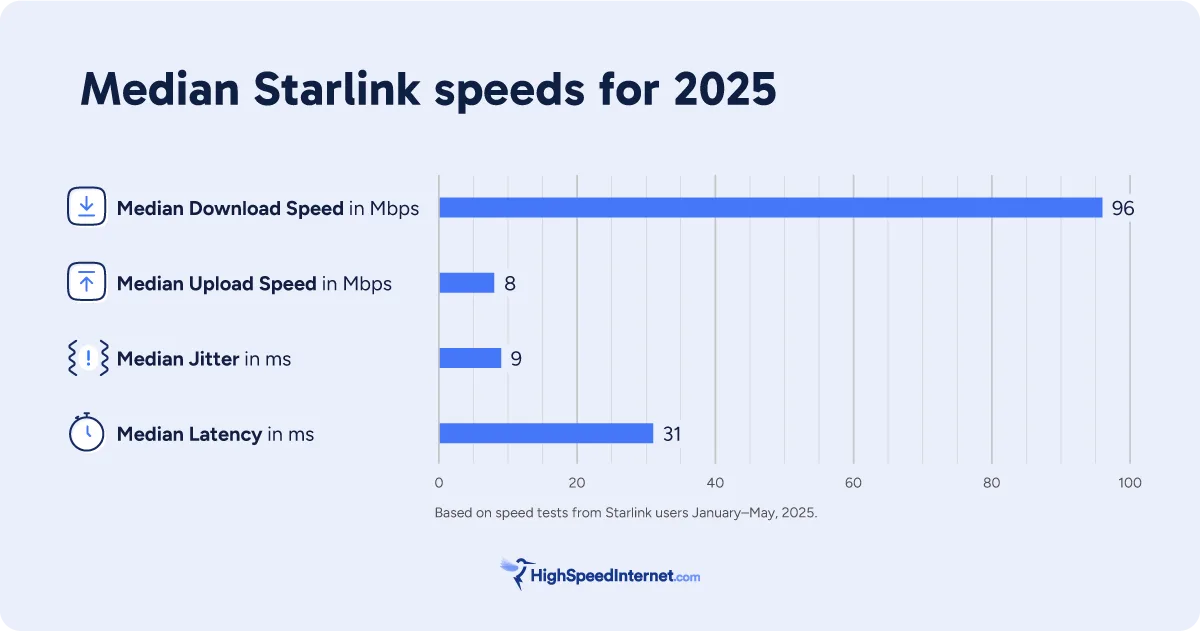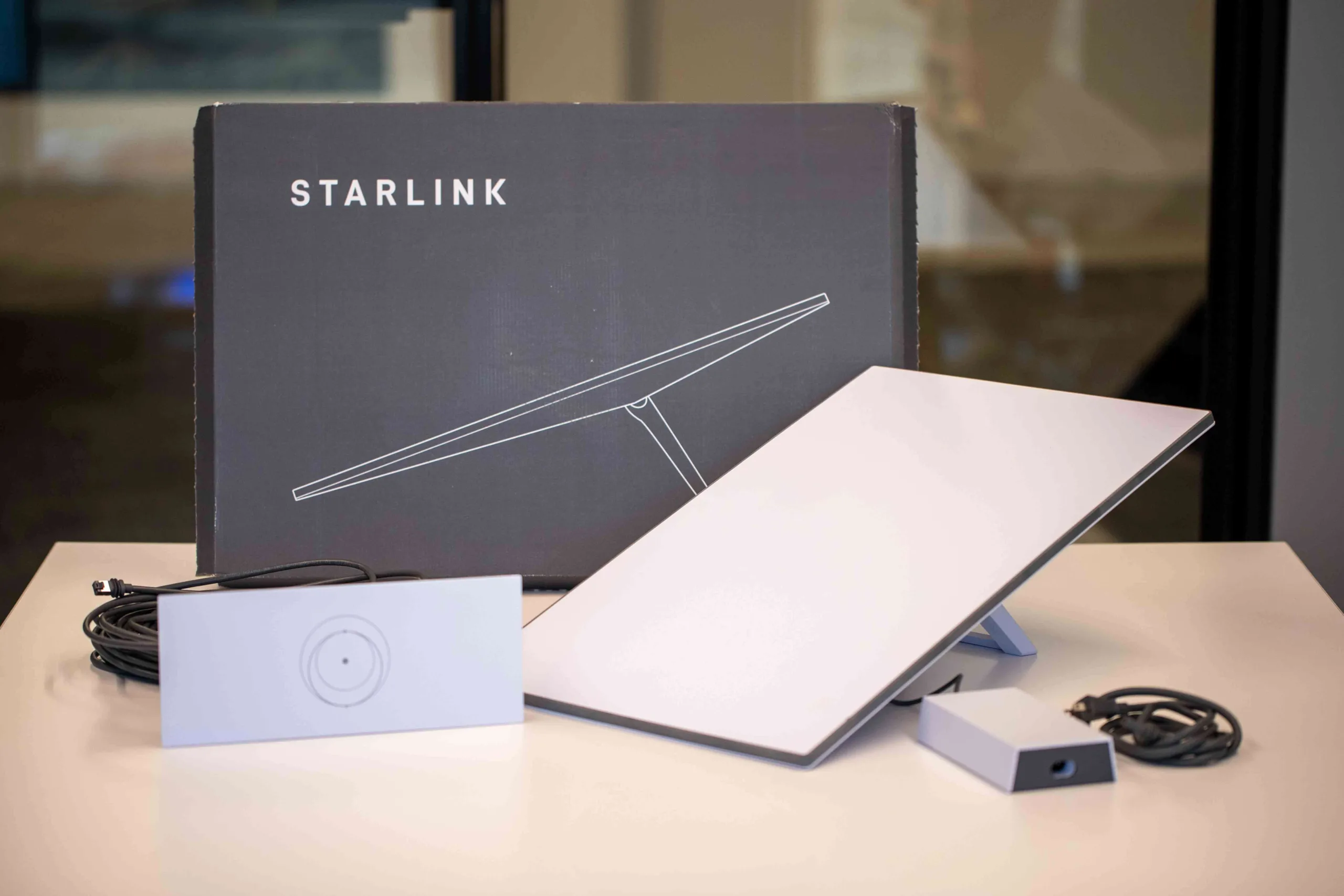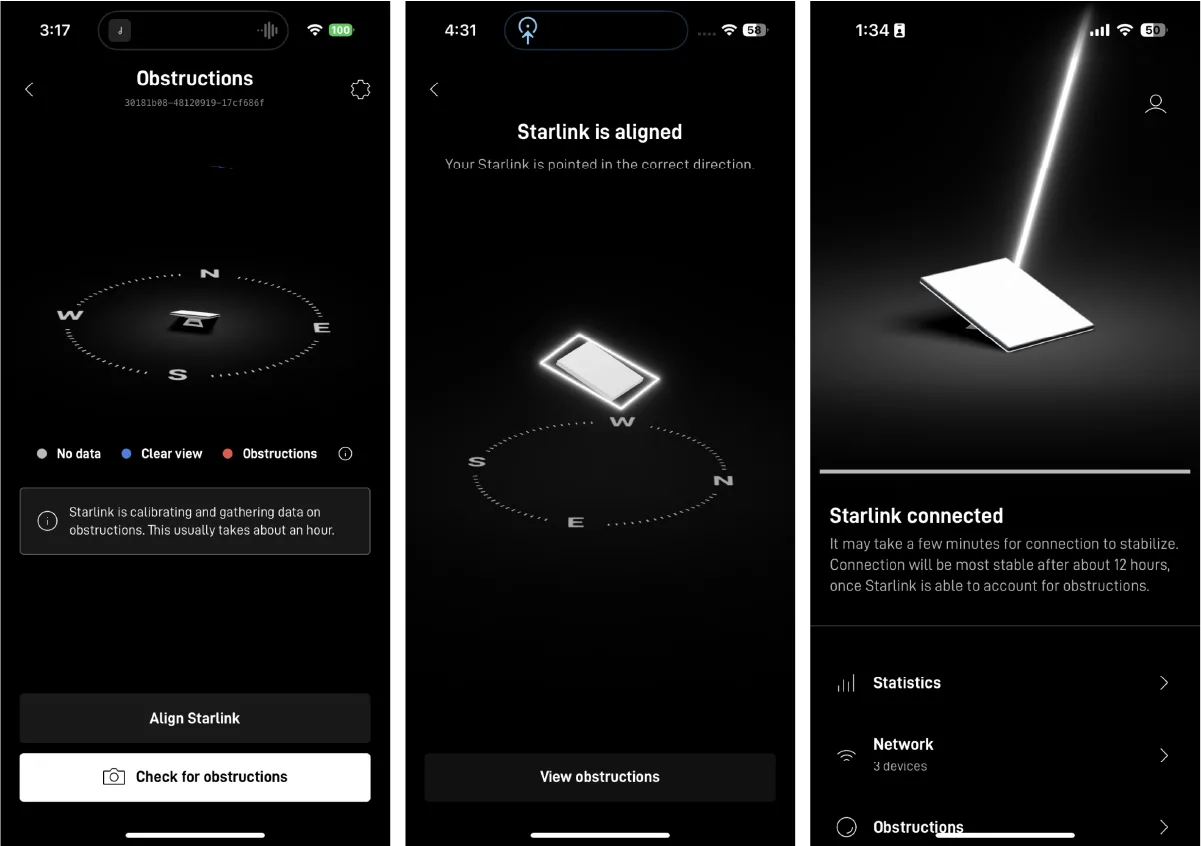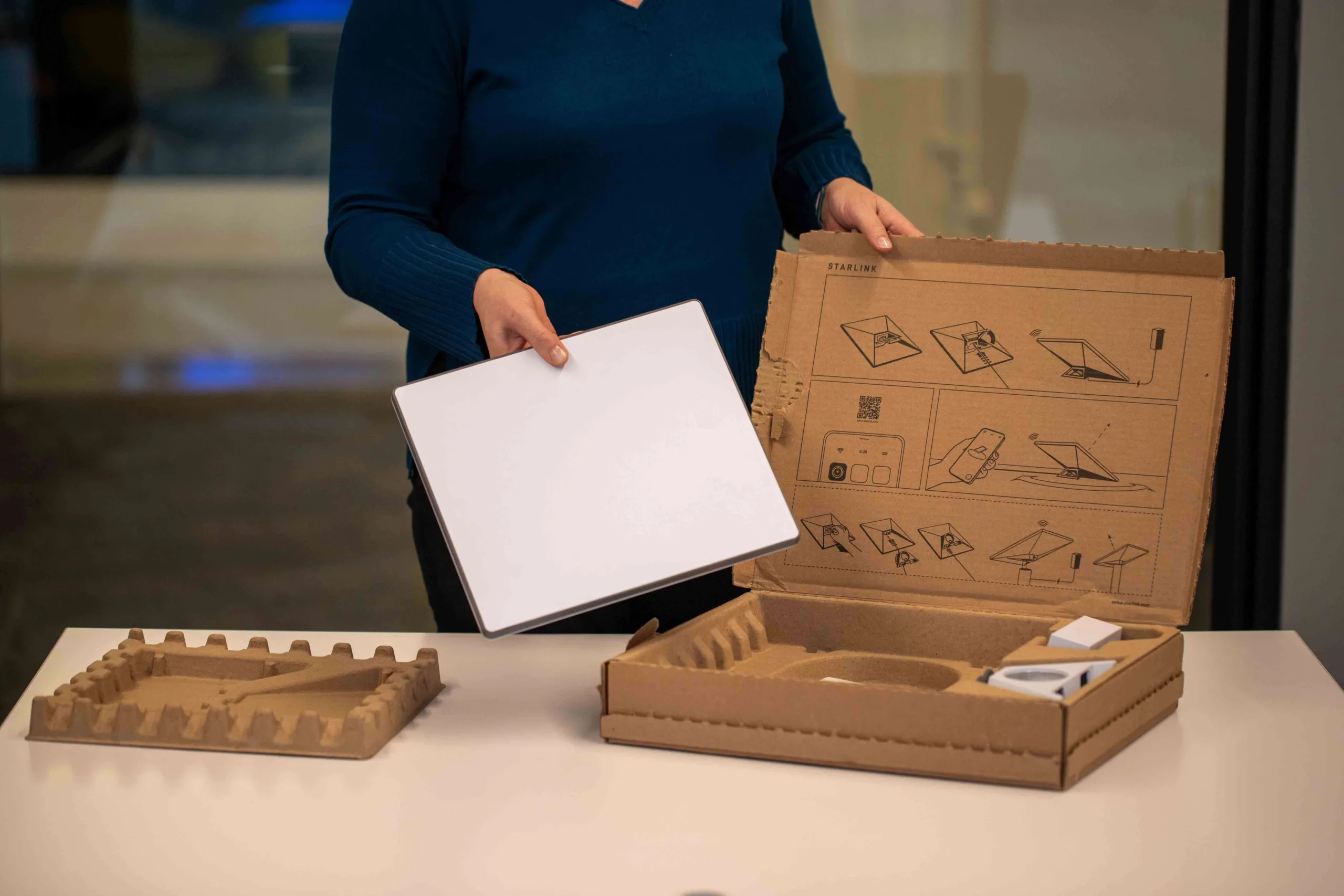My Starlink review
My team and I put Elon Musk’s new Starlink internet to the test, and it did not disappoint! I had speeds fast enough for video calls, gaming, and streaming live sports from the middle of nowhere.
In addition to real-world testing, we read hundreds of customer reviews, interviewed real customers, and took a deep dive into the pricing, plans, terms, conditions, and required equipment.
The short version? Starlink is the cheetah of satellite internet, but even cheetahs have their spots. The service is much more reliable and easier to use than the alternatives, and it’s a true solution for connectivity from virtually anywhere. Downsides include high equipment costs, high monthly prices, congestion-related slowdowns, and problems in case of wind storms or obstructions overhead. You may also run into issues with Starlink-specific cables and finding a stable power source for your Dishy (that’s receiver dish, in non-geek speak).
Pros
Connectivity from anywhere
Stellar mobile app
Enough bandwidth for multiple users
Cons
Expensive startup costs
Confusing pricing
Slowdowns in case of congestion or obstructions
In this review:
Plans and pricing | My favorite plan | Hands-on testing | Use cases | Data caps | Deals | Installation and equipment | Contracts | Starlink vs. the competition | Bottom line | FAQ
In this review:
Starlink plans and pricing
| Package | Price | Speed | Data allowance |
|---|---|---|---|
| Residential 100 Mbps | $40/mo.* | Up to 100Mbps | Unlimited |
| Residential Lite | $80/mo.* | Up to 250Mbps | Unlimited |
| Residential | $120/mo.* | Up to 400Mbps | Unlimited |
| Roam 50GB | $50/mo.† | Up to 300Mbps | 50GB |
| Roam Unlimited | $165/mo.* | Up to 300Mbps | Unlimited |
Data as of 12/01/2025. Availability and speed may vary by location, and prices are subject to change. See disclaimers.
Starlink internet: My favorite plan
Get Starlink’s Residential plan if you need fast, reliable home internet and can’t get it any other way. You get unlimited data and can use a standard Starlink dish, but you won’t get put to the back of the line like you would with a Residential Lite plan.
Is Starlink available where you live?
Enter your zip code below to see a list of the top internet providers available in your area.
Starlink internet hands-on testing

We tested Starlink standard dishes at a mountain cabin in Utah and tested the Starlink Mini in residential and remote locations throughout the Intermountain West. At the cabin, we were impressed with the speeds, the power of the included router, and the low latency (especially compared to other satellite brands we tested). Starlink is the only satellite internet option that works well for streaming TV and gaming in remote locations, but it’s expensive, and setup can be a hassle.
While on the road with the Mini dish, we were impressed that we could stream video or load map apps while driving down the freeway. However, we didn’t always have adequate speed for video calls or gaming. The setup was reliable enough for emergency communications, but we wouldn’t count on it for full-time remote work.
We tested Starlink in a variety of weather conditions, but we always had benefits of low congestion and relatively few overhead obstructions. If you live in an area with a lot of other Starlink customers, you may have to deal with slower speeds. The same is true if you live somewhere with a lot of trees or overhead or if you don’t have a clear view of the northern sky.
Fortunately, Starlink offers a 30-day money-back guarantee on all Roam and Residential plans. If you can’t find a good spot for your dish or find the speeds to be disappointing or unreliable, you can return everything with no questions asked.
Are you a current Starlink customer?
Leave a review or read what other customers say about Starlink.
Starlink home internet speeds
Starlink advertises speeds up to 300Mbps for the standard Residential Plan and Roam plans. If you have a Residential Lite plan, you may see similar speeds, but your signal will be deprioritized relative to other residential traffic.
Your speeds may be slower if there are a lot of other customers in your area. That said, data from our in-house speed test showed that, on average, customers are consistently getting speeds of about 100Mbps.

In our testing, we found that Starlink delivered speeds of nearly 100Mbps and upload speeds faster than 8Mbps most of the time. The average jitter from our testing was 9ms and average latency was 31ms.
Often, our experts saw Starlink speeds that were much faster than the median we saw in speed tests. We never had problems adding multiple devices to the connection at a time and were able to connect the router from several feet away (even on separate floors).
However, we also tracked slower speeds on several occasions. Sometimes, the slow speeds were clearly due to overhead obstructions, windy or rainy conditions, or simply being too far from the router. Speeds were also slow for about 20 minutes whenever we moved the dishes or switched power sources but sped back up once the dish found a secure connection to satellites overhead.
What Starlink Home Internet is good for
Starlink is nearly as good as a DSL or cable internet connection but comes with unique costs and hassles. We tested it in the following scenarios to help you decide whether it’s right for you.
Is Starlink good for working remotely?
Starlink is fast and reliable, and we talked to many people who used it to work remotely for tasks including managing databases, editing files, browsing, and sending emails. However, it was not always sufficient for video calls in our testing. Sometimes, it worked like a charm, but other times, we got kicked out of calls no matter what app or platform we tried.

Pro tip: Check for obstructions, then mount securely
If you’re planning to use Starlink for remote work, make sure your dish is securely mounted in a place where it has an unobstructed view of the northern sky and a rock-solid power source.
Is Starlink good for gaming?
Starlink has low latency and works well for mobile, PC, and online gaming as long as the dish has an unobstructed view of the northern sky and a reliable power source.
“When it comes to latency compared to the other satellite providers, there’s no competition,” says SatelliteInternet.com Staff Writer Andreas Rivera, who ran extensive gaming tests while connected to a standard Starlink dish.
“It’s so much snappier. I’d say it’s the only satellite solution for online gaming.”
–Andreas Rivera, Staff Writer at SatelliteInternet.com
Is Starlink good for live TV streaming?
In our testing, Starlink was fantastic for streaming shows, including sports and live TV. It worked well everywhere we tried it, including remote areas like the middle of the San Rafael Swell and mountain peaks in the Uintahs. We were able to stream in 4K on multiple devices at once with no problem.
Unfortunately, this great streaming experience isn’t guaranteed. One residential Starlink customer in the Washington area told us his connection was occasionally fast enough to play first-person shooters but, other times, didn’t have enough bandwidth to stream Bluey for his kids.
Put another way, Starlink has the technical capacity to work well for streaming, but your mileage may vary.
Does Starlink internet have data caps?
There are no data caps on Starlink Residential plans and one of the Roam plans, but two Roam plans carry data caps: 10GB and 50GB. The 50GB plan is available to anyone with suitable equipment, and you can add on data for $1 per gigabyte if you run out. The 10GB plan is offered only to customers who have had their plans on pause for a long time. With it, you can add on data for $2 per gigabyte.
The 50GB is enough for about a week of moderate internet use. It’s suitable for weekend travelers, but you should upgrade to Roam Unlimited if you use 100GB of data or more per month. The 10GB plan is enough for about a day, and it’s good for folks who use Starlink as backup internet.
Starlink also has data limits on its Priority plans, but those are exorbitantly expensive and overpowered for everyday customers, so we don’t recommend them.
Starlink’s ongoing deals and promotions + bundles
Starlink internet: Installation and equipment
Most people who choose Starlink have to pay for the equipment up front and handle installation on their own. That can amount to hundreds of dollars in up-front costs or a fair amount of hassle if you want to buy used and manage a DIY install.
Starlink residential equipment

Starlink Standard equipment prices
| Standard Kit | $349 |
|---|---|
| Gen 3 router mount | $25 |
| Gen 3 mesh router | $120 |
| Masonry Routing Kit | $46 |
| Cable Routing Kit | $32 |
Data as of 06/18/2025.
The Standard kit typically costs $349, but you can sometimes find deals or refurbished kits at a discount. If you don’t want to buy directly from Starlink, you can buy used equipment or shop directly with retailers such as Best Buy and The Home Depot. Buying new gets you guarantees from Starlink and access to the latest tech, plus it makes it easy to return equipment that doesn’t work out—but it may not be worth the money. We’ve had decent luck with used gear and talked to several customers who are doing just fine with their own older gear.
A kit includes a receiver dish, Wi-Fi router, power supply, Ethernet cable, power cable, and base. You can buy mounting gear from Starlink after you’ve placed your initial order or shop for third-party solutions from a variety of retailers.
Starlink standard kit self-installation
Once everything arrives, it’s up to you to get it powered on and pointed at the sky. For best results, you need a completely unobstructed view of the northern sky. The app will give you instructions and let you know when you’ve found an optimal spot.

Installation could be as simple as zip-tying the dish to an existing post in your yard, but it won’t work well unless you live in an area without a lot of trees, buildings, or other obstructions. If you have obstructions or live at the bottom of the hill, you’ll need to mount the dish on a pole or even up on the roof, and that might require special mounts. You may also have to drill holes for Ethernet and power cable access.
Many people we talked to had the skills and equipment to handle complex installations on their own, but others hired local contractors. You can also pay Starlink for a rooftop installation, with prices starting at $199. The service is available in 35 states.
Another option is to use the Standard Kit with a Roam plan. That way, you don’t need permanent installation, but you’ll have to find a power source in each new spot. Luckily, fellow RVers tend to be a helpful bunch. You can find a lot of great advice on the Starlink forum on Reddit or Starlink for RVers and other mobile users on Facebook.
Starlink Mini kit setup

Starlink Mini kit cost and extras
| Mini Kit | $499 |
|---|---|
| Router Mini | $40 |
| Mini Travel Kit | $45 |
| Mini pipe adapter and flat mount | $28 |
| Mini car adapter | $45 |
| Mini USB-C cable | $31 |
| Mini mobility mount | $22 |
| Mini roof rack mount | $27 |
| Mini Ethernet cable | $35 |
| Mini pivot mount | $10 |
| Mini wall mount | $10 |
The Mini Kit from Starlink includes cables, a power supply, the combo router and receiver dish, and a stand. It’s more expensive than the Standard Kit but fits inside a backpack and doesn’t need to be mounted permanently. It even works in motion, at speeds up to 100 miles per hour.
The instructions in the app for the Mini are identical to the Standard’s, but you’ll probably be setting up the Mini a lot more often. Your speeds and connection quality will vary based on where you set it up.
You’ll also have to find a power source for the Mini in each new spot. You can plug it into a standard wall outlet if one’s available, but you may need a laptop power bank or portable power station.
Learn more about how to power the Starlink Mini.
How do you sign up for Starlink?
You can sign up for a Starlink plan by ordering online or activating equipment purchased from a retailer or private seller.
If you want to purchase equipment from Starlink, start by visiting the Starlink site . Select Order Now under Roam if you intend to travel with the dish, or select the same button under Residential if you plan to mount the dish permanently. From there, you’ll be prompted to enter your address, with options to learn more or view a speed and availability map. Follow the prompts on the screen to complete your order.
If you’ve purchased equipment from another retailer or private seller, you’ll need to activate your Starlink kit instead. You’ll need either the Starlink identifier or the Kit Serial Number. If your dish is used, you will be able to activate it under your account only if it was transferred correctly.
Starlink congestion fees and waitlists
You may encounter waitlists or extra fees during checkout when signing up for Starlink. The highest congestion charge we’ve seen is $500, due either when you purchase a kit from Starlink or activate a kit from another seller.
If you come across a waitlist instead, you have two options. You can either order a Roam plan or enter your contact info and wait for Starlink to tell you service is available. Fair warning, though—you may only be allowed to use a Roam plan in a congested area for 60 days at a time. If you overdo it, you could be forced to upgrade your plan or pay a monthly Roam Unlimited Service fee.
Learn more about what you might have to pay for Starlink.
Do Starlink internet plans require a contract?
Starlink doesn’t require long-term contracts for most plans, but you may have to sign up for a 12-month commitment for certain deals and promotions. Most Residential and Roam plans are typically paid month-to-month.
Starlink internet vs. the competition
| Provider | Starting price | Speed range | User rating** |
|---|---|---|---|
| Starlink | $40/mo.* | Up to 400Mbps | N/A |
| T-Mobile 5G Home Internet | $50/mo.§ w/ AutoPay, plus taxes & fees. | Up to 415–498Mbps | 4.1 |
| Verizon | $50/mo.† w/ AutoPay | 300–2,300Mbps | 3.9 |
| Viasat | $119.00/mo.§ | 25–100Mbps | 3.1 |
| Hughesnet | $39.99/mo.‡ for first 12 mos. | Up to 100Mbps (stated speeds are not guaranteed) | 3.1 |
*** Rating based on a five (5) point system used in our customer satisfaction survey. Higher is better.
Data as of 12/01/2025. Availability and speed may vary by location, and prices are subject to change. See disclaimers.
Starlink’s main competitors are 5G home internet providers and other satellite internet providers.
Compared to other satellite providers, Starlink is the clear winner. It may cost more at the beginning, but it is much faster and easier to use. Plus, you can sell it if you don’t like it (or if fiber internet gets installed in your neighborhood). Viasat and Hughesnet have other benefits. They offer plans that let you tap into local 5G networks if they’re available, for example, but neither can match Starlink for speed and ease of use. And why would you have satellite internet if you can get 5G anyway?
That brings us to Starlink compared to 4G or 5G fixed wireless internet. First, remember that fixed wireless isn’t available everywhere because it depends on excess capacity from local cell towers. That also means it’s only as good as those local towers. However, you’ll pay a lot less for fixed wireless than you would for Starlink, and you won’t have to buy equipment up front. Installation is a breeze, too—just plug in your internet gateway, and you’re good to go.
Shopping for fast home internet?
Enter your zip code for a comprehensive list of providers in your area.
Bottom line: Is Starlink right for you?
Yes, there are compelling reasons to get Starlink Internet but also compelling reasons to avoid it. When it comes down to brass tacks, I recommend it only if you can’t get fiber, cable, or fixed wireless internet or if you’re a heavy internet user who needs a portable Wi-Fi solution.
Starlink is an incredibly powerful tool. You can use it to get connected from almost anywhere, with speeds and reliability that would have been unthinkable just a few years ago. It’s hard to overstate how cool it is to get fast internet from deserts, canyons, and even the middle of the ocean. (OK, we didn’t test that. But hypothetically speaking).
That said, there are four big reasons it might not be right for you. First, it’s not as good as wired or fixed wireless internet, and those connections are already available to almost everyone in the U.S. Second, it’s expensive, both in the beginning and over time. Third, it’s not bulletproof for activities like video conferencing. Fourth, it may become less reliable over time as Starlink adds more customers.
FAQ about Starlink internet
Is Starlink faster than 5G?
How fast is Starlink internet?
Where is Starlink available?
How much is Starlink equipment?
Methodology
Our HighSpeedInternet.com editorial team bases our analyses on customer input from our Annual Customer Satisfaction Survey, results from our speed test tool, and proprietary internet provider data on speeds and pricing. To strengthen our research, we look closely at provider contracts to get hard-to-find information on price hikes, data caps, and extra fees, and we keep tabs on the latest news reports and online reviews. When applicable, we also rely on our personal experiences testing these services.
Disclaimers
Starlink disclaimer
* Plus hardware, shipping & handling fees, and tax. Fully refundable. Depending on location, some orders may take 2 weeks or more to fulfill.
Starlink plans
* Starlink Residential
- Plus hardware, shipping & handling fees, and tax. Fully refundable. Depending on location, some orders may take 2 weeks or more to fulfill.
† Starlink Roam
- Users on Mini Roam are limited to 50GB of Mobile Data and can use in-motion beyond 100mph
Comparison disclaimers
* Starlink
- Plus hardware, shipping & handling fees, and tax. Fully refundable. Depending on location, some orders may take 2 weeks or more to fulfill.
- Users on Mini Roam are limited to 50GB of Mobile Data and can use in-motion beyond 100mph.
§ T-Mobile Home Internet
-
Guarantee exclusions like taxes and fees apply.
‡ Verizon 5G Home Internet
- Price per month with Auto Pay & without select 5G mobile plans. Consumer data usage is subject to the usage restrictions set forth in Verizon’s terms of service; visit: https://www.verizon.com/support/customer-agreement/ for more information about 5G Home and LTE Home Internet or https://www.verizon.com/about/terms-conditions/verizon-customer-agreement for Fios internet.
|| Viasat
- Prices, speeds and availability vary by location. Prices are subject to change. No annual contract or installation fees are required. Monthly equipment lease fees and taxes may apply.
# Hughesnet
-
Minimum term required and early service termination fees apply. Monthly Fee reflects the applied $5 savings for ACH enrollment. Offer may vary by geographic area.
her terms may apply.


